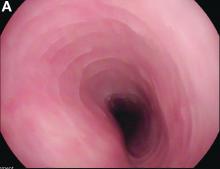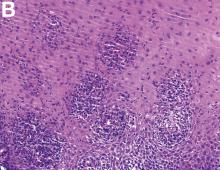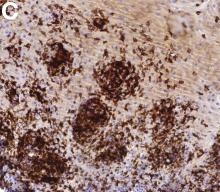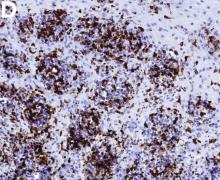The correct answer is C: lymphocytic esophagitis.
Histopathology showed well-differentiated squamous epithelium with dense intraepithelial lymphocytic infiltration of the peripapillary fields without neutrophilic or eosinophilic granulocytes. Focally there were areas with peripapillary intercellular edema/spongiosis (Figure B). There were CD3+/CD4+/CD8+ lymphocytes, without clear predominance of CD4+ or CD8+ lymphocytes (Figures C and D). Upon re-evaluation of the esophageal biopsies from the index endoscopy, neutrophilic granulocytes were reclassified as lymphocytes with shape alterations. Histopathology was diagnostic of LyE on both occasions.The histologic findings of LyE were described in 20061 as abundant intraepithelial lymphocytes in the peripapillary fields of esophageal squamous mucosa with only rare neutrophils and/or eosinophils present. There are reports on associations with reflux, hypothyroidism, Crohn’s disease, allergies, and asthma1,2 but published reports are not unanimous.2,3 The etiology of LyE remains unknown. There is a wide age distribution and no clear gender predominance. The course of LyE is considered to be chronic but benign.2 Endoscopic findings suggestive of eosinophilic esophagitis, such as rings, are observed in 33.6% of LyE patients.3 Presenting symptoms are most often dysphagia or related to reflux. Treatment is symptomatic with PPI or balloon dilatation of strictures.The patient’s dysphagia had improved 3 months following balloon dilation. She declined further follow-up.
References
1. Rubio, C.A., Sjodahl, K., Lagergren, J. Lymphocytic esophagitis: A histologic subset of chronic esophagitis. Am J Clin Pathol. 2006;125:432-7.
2. Cohen, S., Saxena, A., Waljee, A.K., et al. Lymphocytic esophagitis: A diagnosis of increasing frequency. J Clin Gastroenterol. 2012;46:828-32.
3. Haque, S., Genta, R.M. Lymphocytic oesophagitis: Clinicopathological aspects of an emerging condition. Gut. 2012;61:1108-14.
This article has an accompanying continuing medical education activity, also eligible for MOC credit (see Gastroenterology website for details). Learning Objective: Upon completion of this teaching case and questions, the learners will be able to identify one typical clinical and endoscopic presentation of the entity lymphocytic esophagitis, distinguish its histological pattern from other esophageal disorders and recognize a variety of other clinical presentations of this condition.






